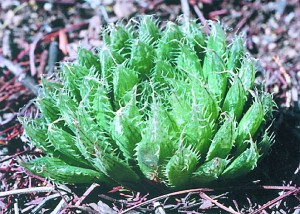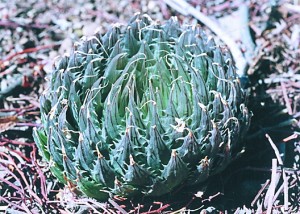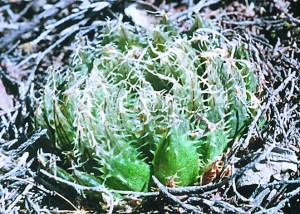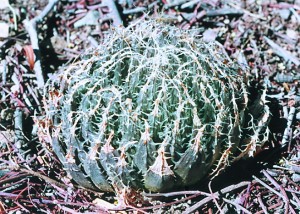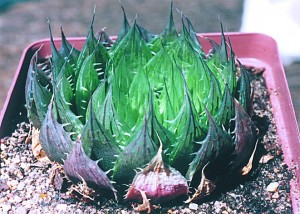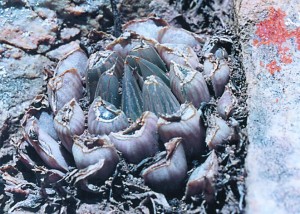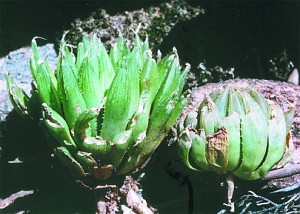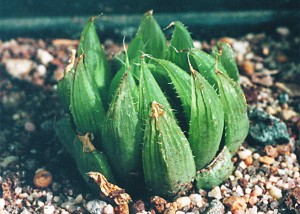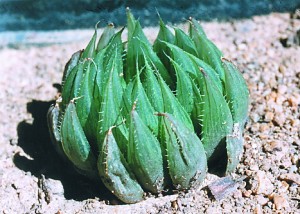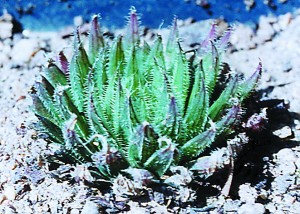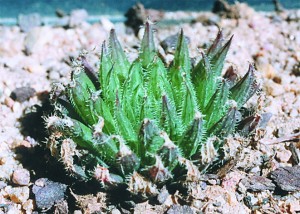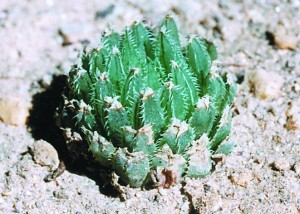The five papers in this book represent analyses and discussion of a large number of collections revolving principally around the problems of the Eastern Cape Haworthia species. The paper regarding H. mucronata does provide some insight into the overall problem. The citations by Von Poellnitz for varieties of H. altilinea and H. mucronata indicate just how difficult it is to differentiate between species such as H. bolusii and H. mucronata, from their respective geographic locations. In the case of H. cymbiformis var. incurvula; then in the case of H. cooperi, H. bolusii var. blackbeardiana, H. aristata and H. decipiens var. pringlei; then H. cooperi, H. gracilis and H. cymbiformis; and finally in the case of Kaboega; it is evident that a better solution can be sought.
During the course of the analyses, it became evident to me that a gracilis-like element is present in every one of the cases. It is less evident in the case of H. mucronata, because I have not presented the data and also because I have not collected sufficiently either. Certainly H. mucronata is closely allied to cooperi, cymbiformis, blackbeardiana and to decipiens. However, it is also very closely intertwined in H. arachnoidea and a lot more field observations are required to determine what its archetypal kinships may be. They may be the same as for cooperi and cymbiformis. Regardless whether or not this is so, the question still arises:- If gracilis is the archetype for so many species which the evidence leads me to suggest it is, what then is this element I call gracilis?
I have always had problems of clearly separating variants of cooperi and variants of gracilis particularly in the Baviaanskloof. Examination of the Middleton, Baviaanskranz (pringlei) and Ripon collections demonstrates the tension that exists in the classification. The two former collections seem to constitute an element which can be differentiated from blackbeardiana and from cooperi (represented mainly by its variety pilifera), albeit with difficulty. That is, it has more slender leaves than either of those species. Thus I must point out that cooperi is problematic because in my 1999 revision, the main geographic component is assigned to its varieties. The typical form of cooperi occupies a no-man’s-land between blackbeardiana and pilifera. A similar situation arises with the discarding of the name translucens for gracilis. The elements which I had previously included as typical for translucens, became the var. isabellae of gracilis. Gracilis itself came to occupy a relative no-man’s-land and possibly only truly represented at its origin at Hellspoort. These problems are discussed in some detail in Haworthia Revisited.
The fact that none of the elements discussed in the preceding papers form clear discontinuities, suggests that I need to seek a better way of expressing the situation and the problem. The Kaboega situation is particularly difficult, and the fact is that we have recognisable cymbiformis, aristata and gracilis var. isabellae, connected by an array of forms which seem to be archetypal of gracilis. At Pluto’s Vale, we have gracilis var. tenera and cymbiformis connected by a small array of a similar archetypal gracilis. In the Baviaanskloof, we have variants of gracilis, and variants of cooperi which are linked through cymbiformis-like picturata to transiens. But there do not there seem to be three discrete species any more than at Kaboega, or at Pluto’s Vale. The same is true of the Ripon (Somerset East) area. There, there are only two elements. In terms of my 1999 revision, one is cooperi (MBB6557) and the other is either blackbeardiana or pringlei (MBB6556). It cannot be both. Furthermore, these two elements seem to be ecotypes of the same species, and proven by their co-occurrence in a third collection (MBB6927) from a differing habitat.
I have suggested that a more technically orientated botanical revision would result in a reduction of the number of species.These previous papers suggest that such species reductions may even be necessary at the present level if we are to maintain coherent communication. The reference to a more technically botanical solution immediately gives me problems, because I do not from my experience see the adequatio to undertake such a task. I here try to summarise, distill and synthesise the conclusions arrived at in my other papers in my own way. The questions I ask are:-
- Is there are common solution to the classification of the variants of Haworthia over the geographic areas of the middle Fish River, the upper Sundays River and the Longkloof (Couga River) and Baviaanskloof (lower Groot River and Baviaanskloof rivers).
- Can any classification solution be offered which provides a better explanation for the variation and the continuities we see in the field?”.
Results
The problem relating to Ripon, makes it quite obvious that we have cooperi var. cooperi, cooperi var. pilifera, cooperi var. dielsiana, bolusii var. blackbeardiana, decipiens var. pringlei and aristata involved in a common discussion.The problem at Kaboega is that we have cymbiformis, aristata and possibly gracilis as emergent elements from a core which could be gracilis. Similarly at Pluto’s Vale, tenera and incurvula emerge from a gracilis core. In the Baviaanskloof, there is a single core which leads either to gracilis, cooperi or cymbiformis variants. In nearly each case I have mentioned two key collections.These are JDV96/89 from Gladhurst, south of Adelaide, and MBB6603 from Glen Craig, north-east of Grahamstown. To this can be added the collection by Gerhard Marx in MBB6845 just east of Alicedale. These are all difficult to reconcile with my 1999 classification concepts of cooperi or gracilis. If we re-examine gracilis, we find that it is only truly represented at Hellspoort, north-east of Grahamstown. Kobus Venter collected there (JDV89/42) and again in 1988. I collected there together with him (in MBB6614) in 1966. Looking at these plants in cultivation and in the light of the classification problem, it becomes obvious that pringlei via particularly the Ripon collection MBB6556, is comparable with gracilis from Hellspoort. With this consideration in mind, it becomes evident that if the concept of cooperi is enlarged to incorporate gracilis, a radically new and more practical solution is presented. The element which I have called gracilis var. gracilis becomes cooperi var. cooperi.
The implications are as follows:
H. cooperi becomes a substantial element which absorbs all the varieties of the obsolete gracilis. The variety dielsiana is abandoned as a variant within the variety pilifera. Cooperi also absorbs pringlei from decipiens in relation only to the collection from the type locality viz. Scott in PRE8970 and two others mentioned in my revision viz. MBB&PVB6561, Baviaanskrans, Patryshoogte, and MBB&PVB6556 from Ripon, both cited under bolusii var. blackbeardiana. It should be noted that no specimen of pringlei was in fact deposited and a letter promising such a specimen occupies the herbarium file. My perception and understanding of the element is from two plants sent to J.D.Venter by Dr Reddi, and also from two plants obtained from Gerhard (J.G.) Marx, all from the ostensible type locality.
Thus cooperi would virtually comprise a superspecies which excludes cymbiformis and its varieties with some difficulty. It would also be difficult to exclude bolusii. Cooperi would in fact absorb the variety picturata of gracilis and could absorb transiens of cymbiformis. A further implication is the variety viridis of gracilis. The evidence suggests that it belongs with cooperi, but that it is interwoven with decipiens and perhaps with xyphiophylla. In this respect, there is not enough data to build a clearer picture of what occurs in the field. There is a similar problem with aristata. There can be little doubt that it is the geographic complement to gracilis and pringlei, and while it is distinctive at Kaboega, there is also the evidence there that it is continuous with cooperi and cymbiformis. There is also the question of the remaining specimens which are cited in my revision under pringlei. These are from the area around Jansenville, where we already know (Lootskloof) that bolusii var. bolusii intrudes, and where we also have a series of greenish plants (Mt. Steward area principally) with numerous erect spinose leaves rather green in colour. They differ from decipiens in having smaller narrower and elongate leaves. These elements need to be further researched and perhaps re-named. Aristata can be linked with these as it does bear a striking resemblance to the darker and bluer forms of decipiens viz. var. cyanea from south and west of Beaufort West.
Conclusion
The first question can be answered with some confidence. There is a solution which can be offered for the portions of the river drainage systems mentioned above. This is to merge the concepts of cooperi var. cooperi, gracilis var. gracilis and part of decipiens var. pringlei.
The second question cannot be answered because of the scope and extent of the problem in relation to the available data. It is quite obvious that small scale collecting and observation is needed. From what has been done, it is very evident that decipiens, bolusii, cymbiformis, arachnoidea and mucronata are very poorly represented in terms of their actual variability. This is particularly true of decipiens. If one considers its geographic central role between mucronata and cooperi, it is predictable that research will disclose some very interesting variants. There are vast areas (in relation to the scale of exploration done at Pluto’s Vale and at Kaboega) which can be regarded as wholly unknown. Particularly void are the areas between Oudtshoorn and Willowmore, and the between Willowmore and Graaff Reinet and southwards to the Cockscomb. The many ranges of hills between the Longkloof and the Zuurberg must hold many populations too, while the mountains to the general north of Somerset East must do the same.
I have done quite a degree of detailed exploration in the south-western Cape which has exposed some extraordinary populations. Some of the variability and endless difference borders on the bizarre, without detracting from the beauty and fascination of the genus. Thus I do not think there is a classification system in the classic sense of dichotomy that characterises taxonomic botany. The variability within Haworthia appears to be highly reticulate and ductile. Many different solutions can possibly be provided which will all be influenced by the material available, and the form in which it is seen by the viewer.
Ironically, my definition of species is that they are systems which are genetically and morphologically continuous in space and time. In my revision I wrote that “I was trying to identify nodes in a complex interlinked web”. This may suggests that the nodes are more important than the matrix in which they occur. I also wrote “… when a variety is selected (described) the balance of variability is loaded towards the typical”. What happened with the recognition by myself of pilifera after I had in my previous Handbooks placed it in synonymy with cooperi, is that it suggested cooperi to have much more substance. Similarly, recognising varieties of translucens and abandoning the name in favour of gracilis, created a similar problem there. Varieties occur as nodes in the matrix of the parent species, just as species do in the matrix of the genus. At some point the discontinuities (in either case) may be obvious and perhaps absolute. I suggest that in the sub-genus Haworthia these continuities are largely obscure. It seems to me that we need to examine the herbarium specimens in terms of a sampling record. It is by now quite substantial, and should thus be considered as a very largely representative of the matrix of the genus. I have become increasingly confident that my classification based on that record, is a good one. Furthermore, that it is has a sufficiently predictive element to accommodate the greater number of new records that will be made.
While writing these papers, I have been carrying some ideas in the back of my mind. These relate to the species in the southern and south-western Cape. I have many new records from there as well, and I am aware of several collections which are otherwise outside of my ken. What I have seen suggests to me that it may be possible to identify the background matrix of an archetype such as I in this work suggest for the eastern Cape (viz. cooperi). ♦


